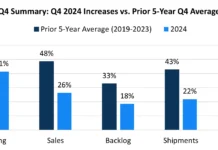
A conversation with Chuck Sholtis, CEO and owner of Plastic Molding Technology Inc.
Approximately 100 miles from Key West lies the Caribbean islands of Cuba, home to more than 11 million citizens. The main island hosts the country’s capital of Havana and, despite the lack of US involvement for more than 50 years, was the destination for more than 3.5 million tourists last year, drawn from Canada, Latin America and Europe by its natural beauty.
Long a political hot button and a source of economic difficulties for Cuba, US relations with the country are beginning to change, opening possibilities for American businesses. President Obama became the first sitting US president since 1959 to visit when he arrived in Havana on March 20 of this year and, although not planned to coincide, a delegation from the Society of the Plastics Industry (SPI) was in the country at the same time. Chuck Sholtis was part of the exploratory team.
The US Embargo of Cuba
According to the US Department of State website:
The United States maintains a comprehensive economic embargo on the Republic of Cuba. In February 1962, President John F. Kennedy proclaimed an embargo on trade between the United States and Cuba, in response to certain actions taken by the Cuban Government, and directed the Departments of Commerce and the Treasury to implement the embargo, which remains in place today.
On March 16, 2016, the Department of the Treasury’s Office of Foreign Assets Control (OFAC) and the Department of Commerce’s Bureau of Industry and Security (BIS) published amendments to their respective regulations to further implement President Obama’s new direction on Cuba.
These amendments, according to the US Department of Treasury, included a loosening of travel restrictions, allowed salary payments and hiring agreements for Cubans traveling to/residing in the US, and authorized purchase of certain goods and services previously restricted under the embargo.
“These changes, coupled with the arrangement recently announced by the Departments of State and Transportation allowing scheduled air service between the United States and Cuba, will significantly increase the ability of US citizens to travel to Cuba to directly engage with the Cuban people,” explained a March 15, 2016, fact sheet issued by the US Treasury Department Office of Public Affairs.
How would you describe conditions in Cuba?

Sholtis: It’s something that has to be experienced. The country is trying to privatize and at the same time, it has been desperately impacted by over 50 years of embargo. Material conditions of buildings, cars and railroad systems were in shambles, primarily due to a lack of ability to import construction materials at reasonable cost.
One of the factories we toured was approximately three hours outside of Havana, and it was like climbing into a time machine. In the rural areas, the farmers were working on horseback and using oxen to till the fields. There was a definite lack of machinery from an agricultural standpoint, and there were no stores in those areas. Instead, a homeowner might leave vegetables on their porch for purchase by neighbors.
Also interesting was the proliferation of ’55 and ’57 Chevys on the road. Automobile imports were frozen at the time of the embargo, and it gives you a jolt to see so many “classics” on the road.
Describe your tour of two Cuban manufacturing facilities.

Sholtis: The first factory was engaged in making woven plastic bags for agricultural products, such as coffee beans and raw sugar. It was an efficient operation but hampered by older equipment. Although looking to privatize that business, much of its production volume is consumed by the Cuban agriculture sector.
The second factory was promoted as a molding facility but actually was a producer of vacuum-formed packaging, such as clamshells for food items. One molding machine was on site, but it wasn’t a recognizable model. After some investigation, it was determined to be a Spanish molding machine that had been brought in through the embargo. A Portuguese hot runner mold was utilized to mold spoons for the hotels. However, the trade conditions made it difficult to source polystyrene, so the spoons were being molded in polypropylene.
In the second facility, the food packaging operations were performed using older Chinese equipment, and at least 50 percent of the equipment on site was offline, as it had been cannibalized for parts to keep the other machines going. Despite those challenges, the facilities were running around the clock and well organized, with clear production goals to be met.
Those are micro examples of what’s going on in Cuba, but it’s indicative of an economy that is having a hard time moving forward. The island is complex – stuck in the past while moving very quickly into the future. Much of Cuba’s industry is owned by the government, and the average Cuban citizen makes only $15 to $25 per month, but the seeds of privatization are planted, with recent approvals for independently run restaurants, barber shops and taxi services.
What are the Cuban government’s goals for industry?
Sholtis: The SPI contingent met with Adriana Barceló Permuy, the general director for industrial management at Cuba’s Ministry of Industry. Much of the reason for the trip – and Cuba’s welcoming attitude – lies in the expectation of an 83 percent increase in tourism over the next five years. Hotels are expected to open 70 percent more rooms to meet the need, and manufacturing opportunities for consumer goods would appear to be growing.
However, the US isn’t the only country interested in the opportunities in Cuba. A report from the ministry stated the US embargo has been the main obstacle for Cuban industry development since 1960, and the country was “forced to choose distant markets” for financing, materials and technology.
Today, Cuba is open about its search for foreign investment and has set up economic zones with tax break opportunities, particularly focused on the Mariel Special Economic Zone (ZEDM). Companies looking to take advantage include Cleber LLC, a tractor company from Alabama with plans to build low-cost tractors for small farms, and Dutch company Unilever, which plans to open a plant employing up to 300 people by 2018. Regardless of the politics, things are happening in Cuba, and it’s probably a good time for the US to re-engage. The Europeans are taking advantage of the opportunities to invest, and Americans could miss out on early growth.
From the plastics industry perspective, what are the opportunities?
Sholtis: The major opportunities appear to be supporting the tourist industry – packaging for food, utensils, cups – very fundamental items. Also, the infrastructure requires big upgrades in sanitation, internet, fiber optics and telecommunications.
As a plastics processor – whether it’s extrusion, injection molding, blow molding or thermoforming – there are going to be opportunities to support the growth as Cuba prepares to deal with the challenges brought on by a growing tourism interest, but caution is still needed. The government has a heavy hand in almost everything, and it’s still unclear what the rules will be for companies wanting to play a role. When will licenses be given out? How long will the waiting periods for approvals be? There’s no way to know right now.
What were the greatest takeaways from the experience?
Sholtis: First, a regime change is not coming anytime soon, despite the embargo. Second, US industry should proceed with caution because we don’t want to lose the opportunities, but we also need to be aware of the risks. Third, Cuba is a beautiful island. It’s exotic and unspoiled, and it’s easy to understand the tourism appeal.
Here in the US, I believe both Republicans and Democrats understand the time has come to work with Cuba. I think they see it makes sense to engage – to explore the opportunities – because the island is going to move ahead in its own self-interest. The Cuban people are ready for more of a market economy, but it will be controlled, at first. There won’t be a sudden unveiling of capitalism, but the country will change, and I saw the seeds of that. It’s very intriguing.




